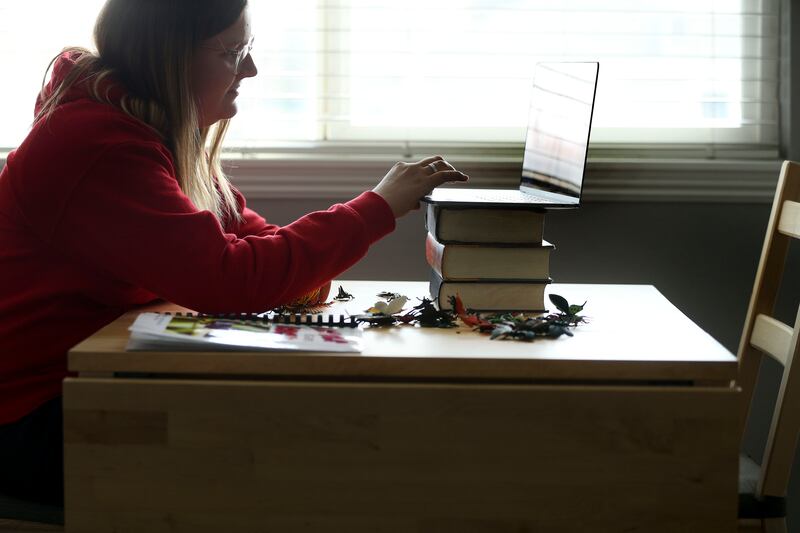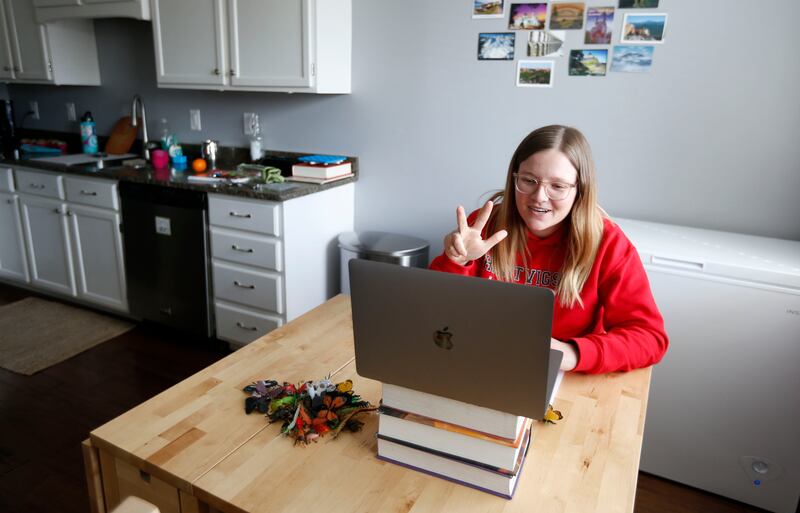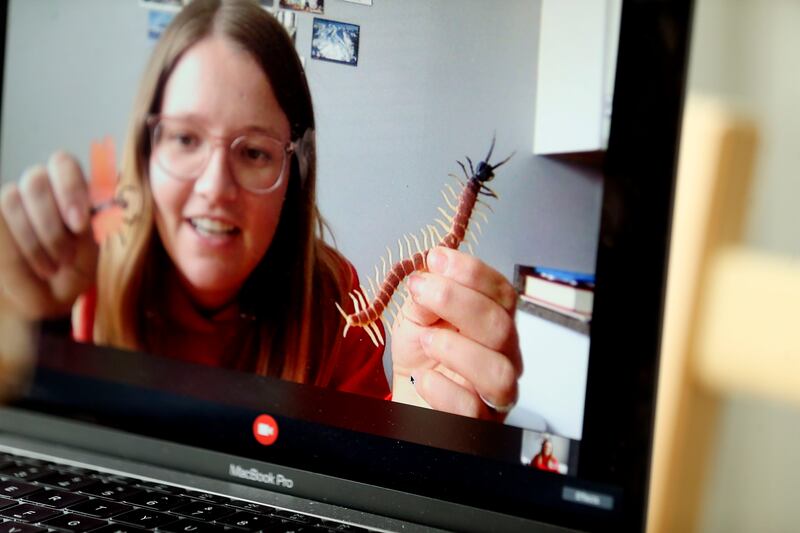SALT LAKE CITY — Technology is enabling Butler Middle School teacher Anna McNamer to continue making human connections with her students. But she’s quick to tell you how much she misses face-to-face interactions with her students and teaching colleagues.
“It’s really hard. I miss my kids,” she said.
At the same time, she’s grateful for her digital teaching and learning training and the technology that allows her to continue to reach her students under highly unusual circumstances.
“This isn’t really something we chose. I think for students and teachers, that makes it a lot harder,” she said.
The soft closure of Utah schools announced by state officials on March 13 to help stem the spread of COVID-19 will now last until at least May 1. The vast majority of Utah teachers are working from home and using a wide array of technology to facilitate learning and keep in touch with their students.
McNamer said it helps that students understand, while they are apart from their teachers, classmates and routines, that they are all in this together, albeit at a distance.
During a recent video conference among one of McNamer’s seventh grade language arts classes, one student showed the class her pet rat. Another donned a gorilla mask and did a little dance.
McNamer said she relished their creativity, getting a glimpse of their home lives and enjoying a moment of levity with her students.
“That’s the whole point of teaching, meeting our students where they’re at.” — Butler Middle School teacher Anna McNamer
“That’s the whole point of teaching, meeting our students where they’re at,” she said.
Christopher Larsen, director of educational technology for Granite School District, said Utah schools have been been “building teacher capacity” with technology over the years. The district encourages teachers to have an online presence on a platform such as Canvas or Google Classroom, and the district has technology coaches and library media specialists to help them.
“Those teachers that took advantage of those opportunities were really well-prepared. And there’s always a percentage that didn’t see value in that that now see a lot of value in it,” Larsen said.
“Overall, we have a lot of resources available and we have access to a lot of programs that have been helpful. We don’t have to go scrambling to purchase anything new to help. So in a lot of ways, I think that we were prepared. I don’t think anybody in the world was prepared for what this virus was going to do to our daily lives, right?” he said.
Digital teaching takes a different skill set to navigate technology, create videos or for some teachers, develop websites.
Communication skills are key.
“You have to be a lot more explicit in your instructions. You have to be really clear on your expectations. Your communication has to be really clear because you don’t have some of those like physical cues. You can’t see when students aren’t understanding, you know, you don’t get to see that glazed over look,” he said.
Not only have teachers been pressed into delivering their content online, they are figuring out the best ways to do that while “students are figuring what it’s like to be an online learner for the first time in a lot of cases.”
At the same time, educators are preparing paper packets of schoolwork to send home with students for families that don’t have internet access. “We’re trying to provide equivalent learning opportunities in a print-based way,” he said.
Larsen said most students experience blended learning in classrooms, which is face-to-face instruction from a teacher and digital learning.
“The best-case scenario will always be a teacher in the classroom with their students. I think digital tools can enhance what teachers are able to do, but they’ll never replace the effectiveness of a good teacher. I’m only the ed-tech director and I’m the first one to say that,” Larsen said.
He said he has been humbled by the innovation and effort of Granite District’s teachers to provide meaningful instruction to their students.
“You put any barrier between a teacher and reaching their kids and they’re going to find a way,” he said.
Samantha Milsap, who teaches severely disabled students at Hartvigsen School, which serves medically fragile students, said she created a website to stay connected with her students and model to parents the instruction their children receive via video recordings so they can work on the same concepts at home.
Milsap credits her teacher education program at the University of Utah for equipping her with the skills to use the latest education technology and best practices to utilize them in a special education setting.
She and the team of paraprofessionals who work in her classroom also assembled bags of instructional materials to help parents build upon what their children have learned this year and continue to work toward their individualized education program goals.
Distance learning for students with severe disabilities is particularly challenging because they heavily rely on routine, personalized instruction and therapeutic opportunities that Hartvigsen offers.
“I can only imagine what my parents are going through with their students at home all the time,” she said.
The school has a therapeutic swimming pool and adapted showering facilities for students who use wheelchairs and other assistive technology. Some parents whose homes are not fully accessible rely on those facilities for their children’s hygiene needs.

Milsap said one goal of her instruction is to help parents teach concepts using items they have at home. For example, silverware or a handful of buttons could be used to teach a simple math concept of more or less or to identify objects that are same or different.
“Spoons and forks are something just about everyone has. They have building blocks and access to picture books,” she said. Her goal is not to burden parents and keep learning going as much as possible.
Much of what happens in a special education classroom is hard to replicate in a distance-learning model but it has been helped by teachers’ visits to students’ homes, which just started this school year, she said.
“I have really good relationships with my parents,” she said. Under normal circumstances she communicates with them daily through an app to discuss their child’s progress and behavior.
“You put any barrier between a teacher and reaching their kids and they’re going to find a way.” — Christopher Larsen, Granite School District’s director of educational technology
Earlier this week, while the classroom team was getting bogged down while preparing take-home instructional materials, they stopped to look at photographs of their students and they were reminded why they work in special education.
“It’s those moments of joy and excitement,” she said.
Still, it is frustrating that the disruption in classroom instruction, routines and behavioral management comes at time in the academic year when students typically make the most progress because there are fewer breaks in the school schedule, Milsap said.
It remains to be seen what the soft recess will mean in terms of students’ learning or gains.
“For us, most of our students will stay at our school until they are 22. Ninety percent of my class will be back next year,” she said.

For that, she is grateful because there are educators teaching high school seniors or children finishing middle or elementary schools who may not see their students again if state leaders decide to extend the soft closure until the end of academic year.
“It would be really hard not to say those goodbyes,” she said.
McNamer, who is in her 10th year of teaching, said she has taken advantage of digital and teaching training opportunities over the years.
As she shifted her classroom instruction to online platforms, video conferencing and other technology, it wasn’t a huge leap. She also works at a school well supplied with Chromebook laptops, thanks to a grant the school received a couple of years ago.
Most of her students have the decided advantage of “recreational technology skills,” which help them navigate academic technology. “That relationship is becoming more clear and applicable,” she said.
While she is able to communicate and guide instruction, McNamer says she misses the human interactions with students that inform her whether they understand a concept, which in the classroom is easily communicated by a simple thumbs-up gesture or a nod of the head.
“You can’t see their eyes light up from here. You can’t hear then take a deep breath when ‘I finally got it,’” she said.
McNamer said she also misses collaborating with her teaching colleagues — dropping by their classrooms to discuss content that straddles their areas of expertise to ask, “‘How can we build on that?’ You miss out on those connections. Now, everything has to be a lot more intentional.”
In many ways, McNamer said she is grateful she and her students are living in an age when technology makes it possible to keep teaching and learning under challenging circumstances.
Still, there are other challenges to what has become the new normal for Utah students and educators.
Most middle schoolers aren’t developmentally prepared to be responsible for their own learning, she said. They are being asked to keep a schedule, access learning materials without teacher and peer support and do their school work.
That’s on top whatever responsibilities students may have at home.
“We have to be flexible. I have so many students babysitting siblings who might only see their parents an hour a day,” McNamer said.
Some of McNamer’s students are anxious that they may be losing ground educationally.
During a recent video chat, one student asked McNamer, “Is our generation going to be dumb because we missed school?”
McNamer reassured her, “You’re going to have so many extra skills because you had to be independent,” never mind the technological gains of learning to use new platforms and video technology for learning.
She predicts that when teachers and students are able to meet in classrooms, they will have a greater appreciation for one another and sharper technology skills.
“We’re so lucky this is happening right now when have options to interact with each other online,” she said.


